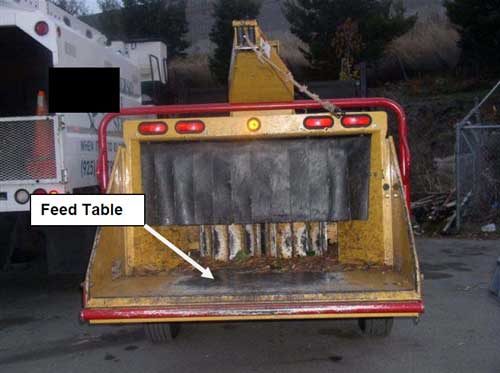FACEValue: Tree trimmer suffers fatal neck injury on wood chipper feed table

Case report: 10CA010*
Issued by: California State Fatality Assessment and Control Evaluation Program
Date of incident: Nov. 15, 2010
A 33-year-old groundsman working on a tree-trimming crew died when a climber’s rope was pulled into a wood chipper. The victim had worked as a tree climber and groundsman for the company for eight years. The company had a written Injury and Illness Prevention Program that included management and employee responsibilities, safety meeting schedules, training, safety incentive and disciplinary programs, and overall safety procedures for two activities related to tree services. The victim was feeding a tree branch into the wood chipper when a co-worker’s climbing rope became tangled in the branch. As the tree branch entered the chipper, the rope became taut, and the victim was either dragged or propelled onto the feed table, striking his head. Co-workers began CPR and continued until emergency crews arrived. The victim was pronounced dead at the scene. The cause of death was a blunt force neck injury.
To prevent future occurrences:
- Ensure cut tree branches are staged and free of obstacles before being fed into wood chippers. All cut branches and brush should always be inspected prior to being fed into wood chippers. Had the victim taken the time to inspect the cut branches prior to feeding them into the wood chipper, he might have noticed the entangled rope and prevented this incident from occurring.
- Assign another employee to be a safety watch whenever cut tree branches are being fed into wood chippers: In this incident, the victim was working alone even though two other employees were working on the ground performing similar functions. A designated safety watch stationed near the chipper may have noticed the rope entangled in the cut branches and prevented the victim from feeding the branches into the wood chipper.
*This report is the product of NIOSH’s Cooperative State partner. The findings and conclusions in each report are those of the individual Cooperative State partner and do not necessarily reflect the views or policy of NIOSH.
Post a comment to this article
Safety+Health welcomes comments that promote respectful dialogue. Please stay on topic. Comments that contain personal attacks, profanity or abusive language – or those aggressively promoting products or services – will be removed. We reserve the right to determine which comments violate our comment policy. (Anonymous comments are welcome; merely skip the “name” field in the comment box. An email address is required but will not be included with your comment.)

